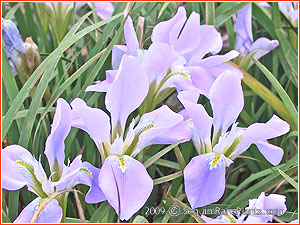
Iris unguicularis 'Walter Butt'
 Iris unguicularis 'Walter Butt'
Iris unguicularis 'Walter Butt'• Click here to visit our Main Plant List page for current availability of this plant
• common name: winter iris
• flowering season: winter, opening new flowers during mild weather
• height: 12 inches, flowers slightly lower
• Light requirements: sun, afternoon shade where summers are especially hot
• Soil requirements: average
• Water requirments: average
• Growth habit: grows as a slowly expanding clump
• How to propagate: dividing in early summer
• Leaf type: upright narrow blades of green
• Ways to use it: plant it with other lower stature perennials in a sunny garden bed; or it would be content to live in a pot, and you can move it up to a larger pot every two or three years
• Special characteristics: very delicately tinted flowers
• Other points of interest: although it cannot withstand severe winter cold, this is not a delicate plant that needs to be pampered; it may only need to be pampered when it is at the edge of its comfort zone
Another, older name for this species is, Iris stylosa. It is native to North Africa and the Eastern Mediterranean. This variety, 'Walter Butt,' has wide petals of very pale, pinkish lavender. You will read that this winter-flowering iris needs dry ground and lots of warmth. It does grow well in these condtitions, once it has gained some size, although in my experience dry ground and lots of warmth are not necessary. Our climate here on the coast is very cool and this iris does well. The ground where it is placed is not dry, but instead is well-nourished and moist. What seems essential is having enough patience to allow it two or three years to grow thickly enough, before expecting much flowering. For the first few years after planting you may doubt that it can flower for many months. It can and will for you in its own sweet time. An older clump starts to flower in November and continues through winter into early spring. A clump that is a foot or more wide, can produce dozens of flowers in a season. Digging it up to see what's causing all of the flowers, you would see a conjested tangle of branching, inter-locking rhizomes. Allowing the roots to grow this way and not constantly replanting it insures the greatest amount of flowers. A plant will stop flowering in the middle of winter when the temperature drops to +15°F, and resumes flowering when the temperature rises. Hardy to USDA Zones 7 to 9, and to Zone 10 in the West. Some gardeners have it survive into Zone 6.